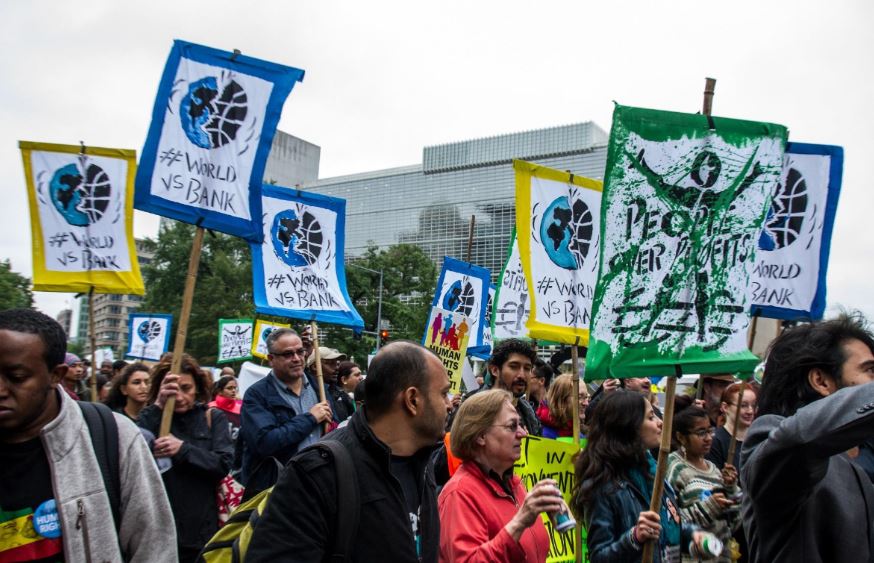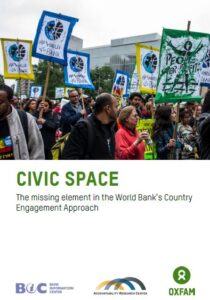
Shrinking Civic Space: How Can the World Bank Respond?
Date: October 2022
Author(s): Rachel Nadelman, Christian Donaldson, Katelyn Gallagher
Publication type: Blog
Published by: Oxfam International
In an environment where people might be targeted or threatened for raising critical perspectives, is a public forum the appropriate place to ask them to share their views on government-backed development projects, such as a road or dam? Are the results of such engagement likely to yield genuine and representative responses? The common-sense answer to both questions is, ‘no’. Yet the World Bank risks putting civil society and project affected communities at risk when acting on its high-level citizen and stakeholder engagement commitments without adequately understanding the contexts where such engagement happens.
The World Bank finances development projects in borrowing countries around the world, including in complex and fragile contexts, often without first fully understanding and addressing the dynamics of civic space. ‘Civic space’ refers to the political, legislative, social and economic environment in which individuals, communities, civil society organizations and social movements are (or are not) able to speak out about the public decisions that affect their livelihoods and hold decision-makers to account. Shrinking civic space takes many forms. This can include repression of peaceful protest and civil disobedience under the guise of national security public interest. It can manifest as increased government restrictions and suspensions of political and civil rights, including crackdowns on free media and reduced tolerance of criticism and public debate. Restricted civic space is known to chill dialogue. These conditions prevent the World Bank from implementing inclusive projects based on meaningful stakeholder engagement and adapting programs to local contexts, thus hampering its ability to achieve robust development outcomes.
Despite this, the World Bank is in fact well positioned to identify and mitigate civic space risks. A new report from Oxfam, Bank Information Center, and the Accountability Research Center makes the case for the World Bank to systematically assess civic space in borrowing countries as part of its “Country Engagement Approach,” the cyclical process of creating country-targeted development strategies. Such systematic analysis of civic space would enable the World Bank to identify potential constraints to safe engagement and find opportunities to strengthen the enabling environment for participation. This would include identifying and understanding those regulations, norms and practices — formal and informal — that define the size and nature of a country’s civic space and determining when official and unofficial discourse delegitimizes and undermines civil society and social movements. This would equip the World Bank to more adeptly address the actual circumstances in which people participate, including by adjusting plans and operations so that potentially affected people and other stakeholders are kept safe when expressing their views.
If the World Bank already has the necessary mechanisms to systematically assess civic space in borrowing countries, what holds it back? A lack of requirements, operational guidance and institutional incentives. This must change.
The World Bank acknowledges that to be successful, development must be inclusive of and responsive to stakeholders. It even aims to contribute to building sustainable national systems for stakeholder engagement. However, this cannot be accomplished without having first determined whether the state of civic space in a country will allow for effective participation in open dialogue, without fear of retaliation.
For the World Bank to effectively meet its high-level commitments to citizen and stakeholder engagement it must take concrete actions including:
- Conduct rigorous and regularly-updated analysis of civic space for each country where the World Bank plans to operate, and include implications of that analysis when assessing the constraints and opportunities for poverty alleviation, a key element within the World Bank’s Country Engagement Approach.
- Allocate adequate budget and build staff expertise to effectively and sensitively conduct civic space analysis that will then be included in the Country Engagement Approach and used to inform country partnership and project decisions.
- Invest in research into the connections, barriers, and opportunities between civic space and development outcomes, to clarify the need for the World Bank to conduct civic space analysis as part of the Country Engagement Approach and the relevance of such assessments to the success of World Bank operations.
- Include findings from country-level civic space analysis in dialogues between the World Bank and borrower governments, including during the planning processes for carrying out the Country Engagement Approach.
- Develop new guidance for project teams to use baseline data from country-level civic space assessments when screening for project risks relevant to stakeholder engagement and when designing and reviewing borrowers’ plans for quality stakeholder engagement, so that risks associated with restricted civic space, such as reprisals against project stakeholders, can be mitigated.
For more information on findings and recommendations, read the full report here.
For an example of a civic space analytical tool, take a look at Oxfam’s Civic Space Monitoring Tool here.
Note: This blog was co-authored by Rachel Nadelman of the Accountability Research Center, Christian Donaldson of Oxfam International, and Katelyn Gallagher of the Bank Information Center. It was first posted on the Oxfam International blog on 12 October 2022, and also posted by the Bank Information Center.
Rachel Nadelman (Accountability Research Center)
Christian Donaldson (Oxfam)
Katelyn Gallagher (Bank Information Center)

